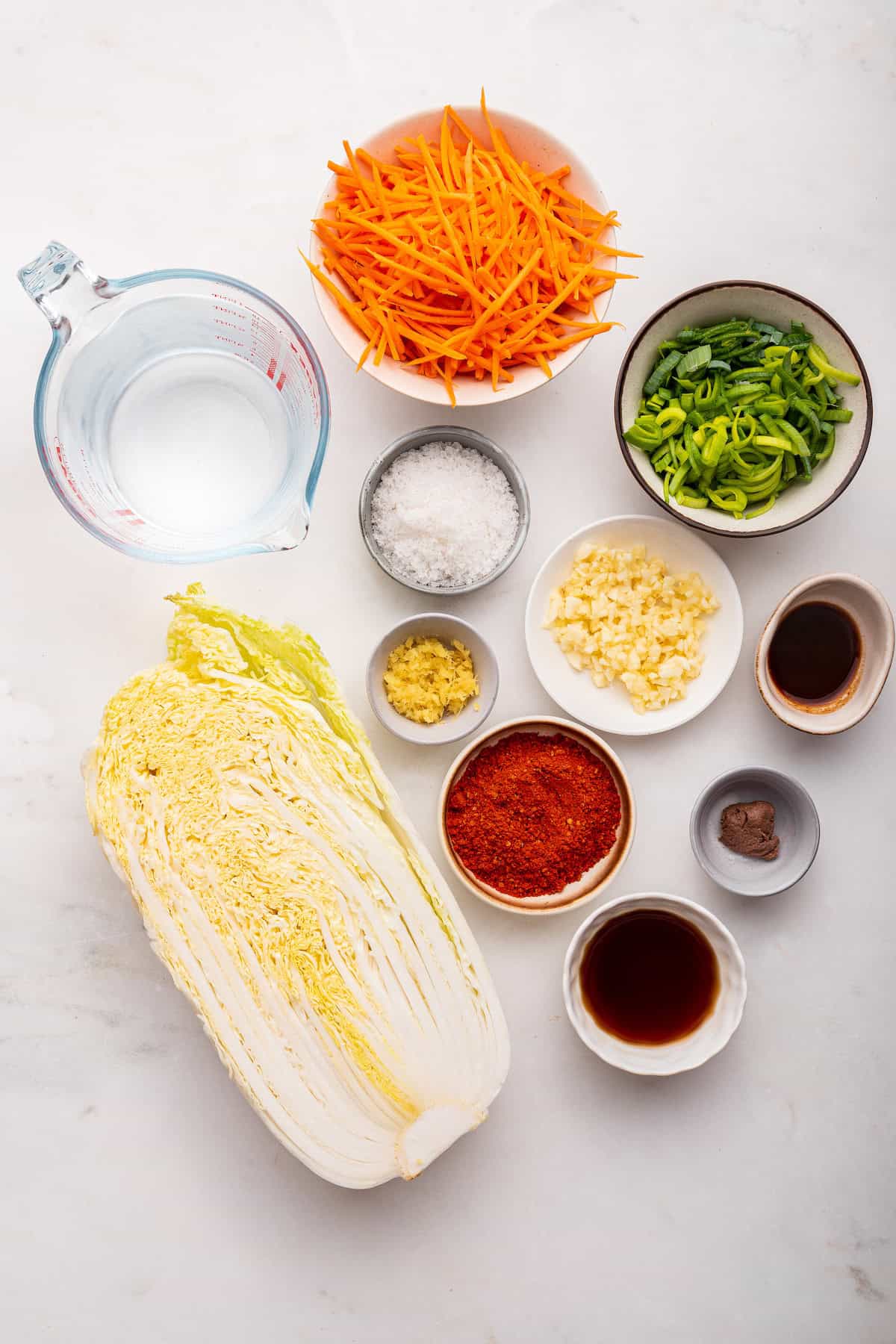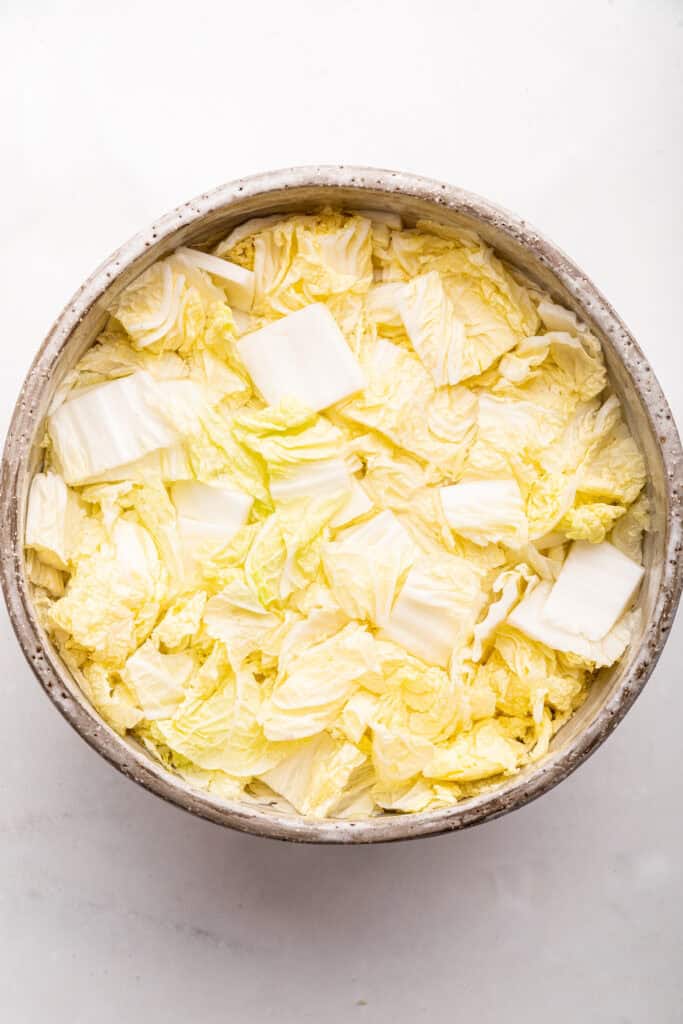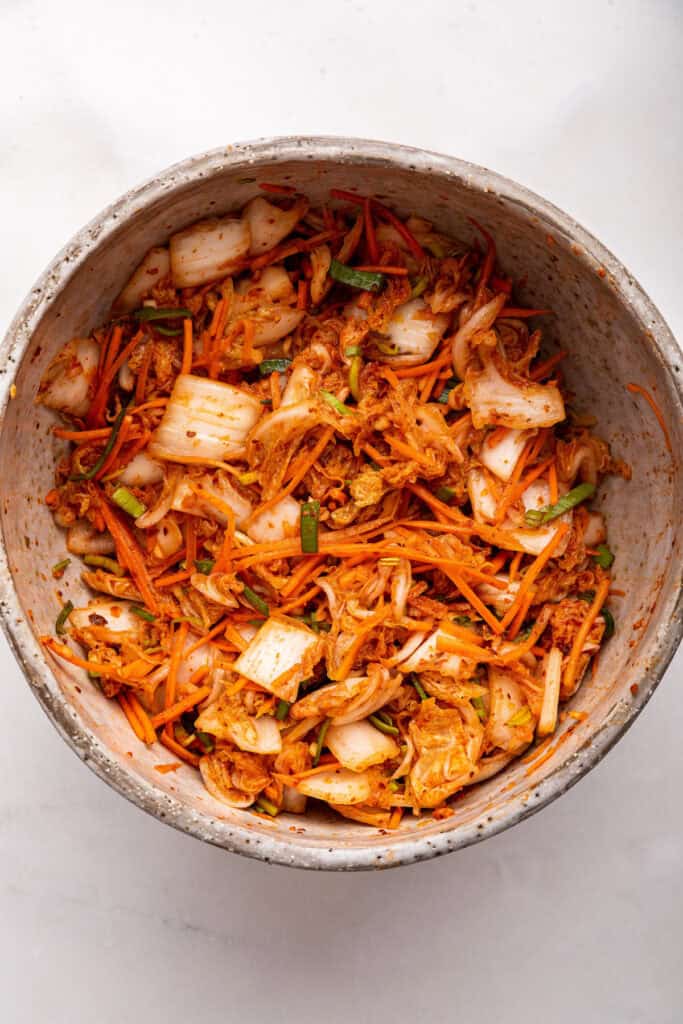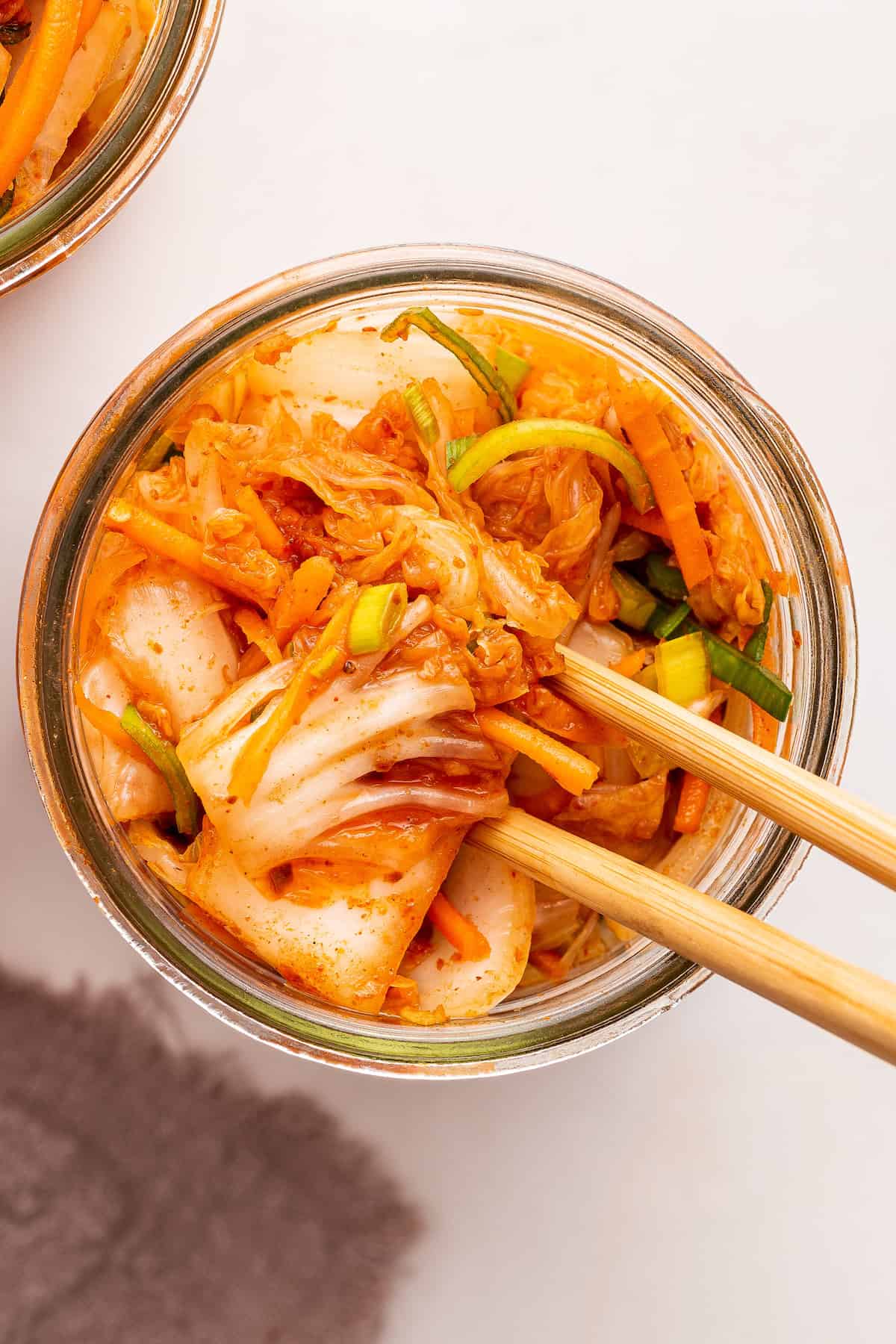If you love kimchi, try your hand at making this kimchi recipe from scratch. Making it yourself means you can customize it to your tastes—plus it’s fun to DIY it!

Kimchi is one of my favorite condiments. I add it to power bowls, put it on pizza, and even use it to make kimchi fried quinoa. It's an easy and flavorful way to add some spice and gut-healthy goodness to my meals.
Kimchi is easy to find at the grocery store and if you have a specialty market you'll often find many varieties to choose from. But kimchi is also simple to make from scratch. The benefit here is that you can tailor the spice and flavor profile to your tastes. Today we're going to learn how to make this versatile fermented food at home.
Why You’ll Love This Kimchi Recipe
- The satisfaction of homemade. Sure, you can buy kimchi at the grocery store, but there's something special about making it from scratch. Not only do you have control over the ingredients, but there's also that sense of accomplishment you get from making something yourself!
- Customizable to your taste. The beauty of this homemade kimchi recipe is that it can be tailored to suit your taste preferences. Adjust the spiciness level by adding more or less chili pepper, or experiment with different vegetables and seasonings.
- Nutrient-rich and gut-friendly. Kimchi is a powerhouse of probiotics and vitamins thanks to the fermentation process. These beneficial bacteria promote good gut health and boost the immune system, making kimchi not only tasty but healthy too.
What Is Kimchi?
Kimchi is a traditional Korean recipe made from fermented vegetables, with Napa cabbage being the most common ingredient. Although kimchi recipes vary, it’s typically flavored with ingredients like chili pepper, garlic, ginger, and shrimp paste, which give kimchi its distinctive taste. You can use kimchi as a condiment or serve it as a side. Want to know more? Check out: What Does Kimchi Taste Like?

What You’ll Need
Here's a quick look at what you'll need to make kimchi at home. Scroll down to the recipe card to find a printable list.
For the Cabbage:
- Napa cabbage – If you’re outside of the US, you most likely know this as Chinese cabbage.
- Kosher salt
- Water
- Leeks – Be sure to wash these well, as they can collect grit between the layers.
- Carrots – Peel the carrots, then cut them into matchsticks. I find that full-size carrots have a better flavor than baby carrots.
For the Seasoning Sauce:
- Garlic
- Fresh ginger – Don’t swap in ground ginger! Fresh ginger is much more pungent and zippy.
- Plum sauce
- Korean chili
- Fish sauce – A fermented condiment that adds umami, sweetness, and a little bit of funkiness (in a good way).
- Shrimp paste – You can find this in Asian markets or order it online.
How to Make Kimchi
Now that you know what you'll need, let's look at how to make kimchi step-by-step:



- Prepare the cabbage. Cut it in half lengthwise, quarter it, then cut the quarters into strips.
- Soak the cabbage. Transfer the cabbage to a large bowl and add salt between the layers. Cover with water and soak for 2 hours, stirring every 30 minutes.
- Rinse. Drain the cabbage and rinse it with cold water. Let it sit in a colander.



- Make the sauce. Stir together the garlic, ginger, plum sauce, Korean chili, fish sauce, and shrimp paste in a large bowl.
- Add the vegetables. Gently squeeze water from the cabbage and add it to the sauce, along with the leeks and carrots. Mix with your hands.
- Ferment. Transfer the kimchi to an airtight container and ferment for a few days.

Tips for Success
- Use filtered or distilled water. Using water with chlorine can inhibit the fermentation process. By using filtered or distilled water, you'll ensure that your kimchi ferments properly.
- Use iodine-free salt. Kosher salt, Himalayan salt, or sea salt are great options. Salt with iodine will interfere with fermentation.
- Wear gloves while mixing. The chili pepper used in kimchi can cause irritation to your hands, so it's best to mix the cabbage and seasoning sauce wearing disposable gloves.

Variations
- Make it vegan. To make this recipe vegan, omit the fish sauce and shrimp paste. You can swap in a vegan fish sauce (which is usually made with seaweed) or simply use soy sauce.
- Try different vegetables. While napa cabbage is the traditional base for kimchi, you can also experiment with other vegetables such as daikon radish, green onions, or even Korean pears.
Ideas for Using This Kimchi Recipe
- In stir-fries. Kimchi gives recipes like this Broccoli Tofu Stir Fry a flavor boost.
- As a sandwich filling. Kimchi is excellent in so many sandwiches, and it's even surprisingly delicious in this Air Fryer Grilled Cheese.
- Topping for tacos. Add some zip to these Crispy Fish Tacos.
- In meal bowls. A spoonful of kimchi is fantastic in these Salmon Bowls, or use it to make Spicy Kimchi Quinoa Bowls.
- For fried rice. Or this 5-Ingredient Kimchi Fried Quinoa!

How to Store
Once the kimchi has fermented to your liking, store it in an airtight container or jar in the refrigerator. It will continue to ferment slowly and can be kept for up to several months.
More Asian-Inspired Recipes

Kimchi Recipe

Ingredients
For the cabbage:
- 1 napa cabbage around 2.5lb.
- ¼ cup kosher salt
- 3-4 cups water filtered or distilled (or as much as needed to cover the cabbage)
- ½ cup shredded leeks
- 64 ounces carrots peeled and cut into matchsticks
For the seasoning sauce:
- 6 garlic cloves finely chopped
- 1 ½ teaspoon fresh ginger finely grated
- 1 teaspoon plum sauce
- 3-4 tablespoons Korean chili
- 2 tablespoons fish sauce
- ½ teaspoon shrimp paste
Instructions
- Prepare the cabbage: cut the cabbage in half lengthwise, then into quarters starting from the stem.
- Cut each quarter crosswise into 1 ½-inch wide strips.
- Place the cabbage into a large bowl, adding salt between the layers of the cabbage. Use more salt closer to the stems, where the leaves are thicker.
- Add enough water to cover the cabbage, and let the cabbage rest for 2 hours. Stir and turn the cabbage every 30 minutes so they get well-salted.
- After 2 hours rinse the cabbage under cold water. Set the cabbage in a colander to drain well.
- Prepare the seasoning sauce; combine garlic, ginger, plum sauce, Korean chili, fish sauce, and shrimp paste in a large bowl.
- Gently squeeze water from the cabbage and add it to the bowl with the seasoning sauce.
- Add leeks and carrots as well. Mix all by hand, wearing disposable gloves.
- Transfer the kimchi to an airtight container or jar. Press the kimchi so it is well-packed.
- Allow the kimchi to ferment for a few days before serving, or serve it just chilled.
Notes
- Use distilled or filtered water, because the water with chlorine may inhibit fermentation.
- Use iodine-free salt, which will not interfere with fermentation. Kosher salt, Himalayan salt, or sea salt are great options.
- You can cut the cabbage into 1 ½-inch wide strips or just cut the cabbage into quarters.

